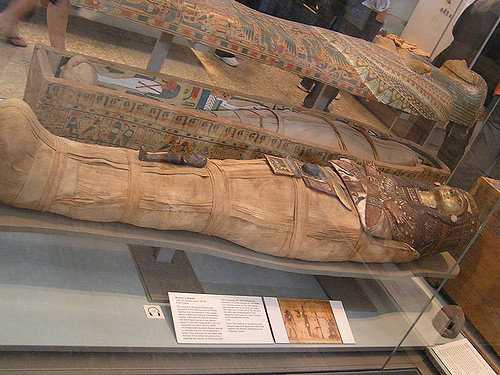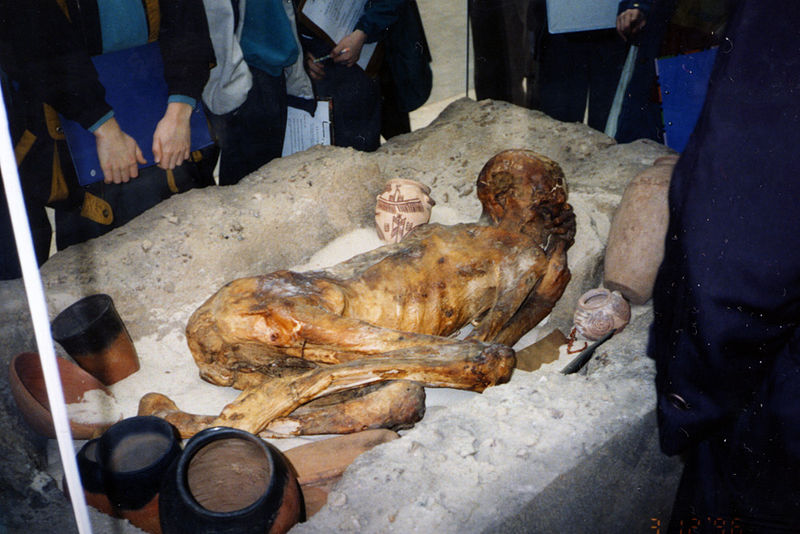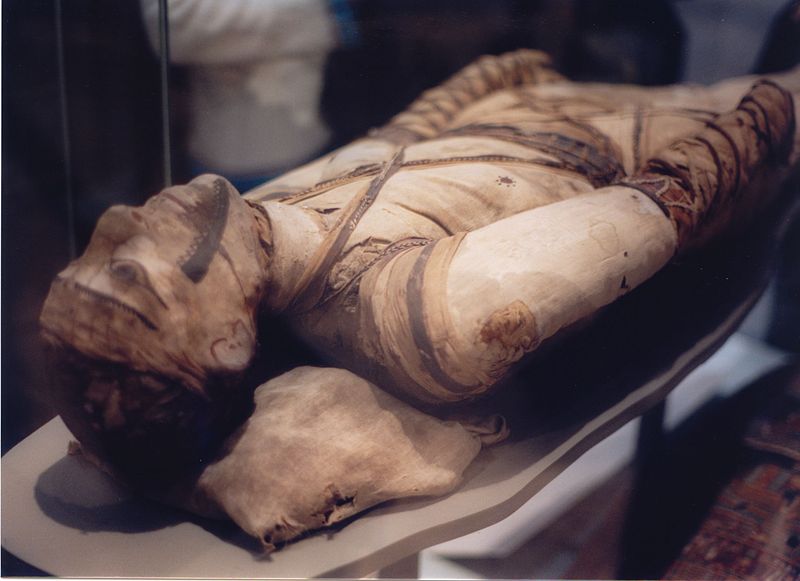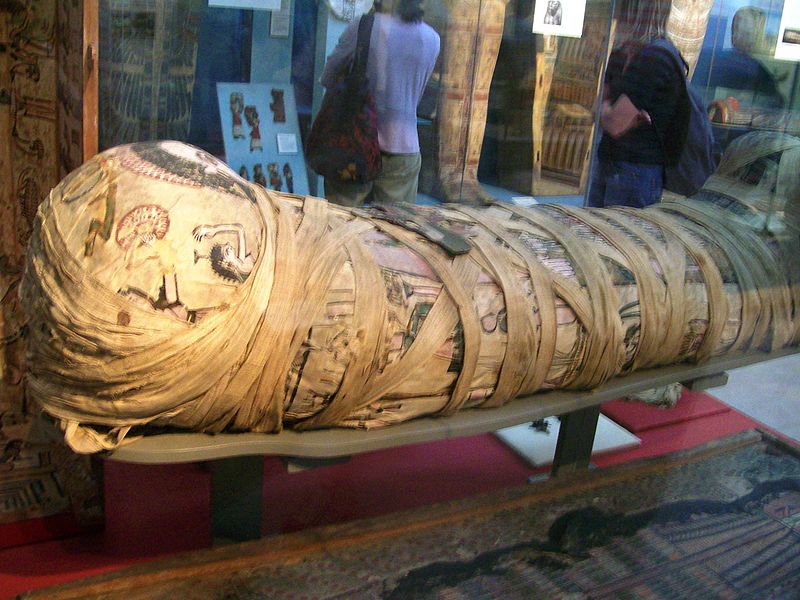Difference between revisions of "Mummies of Ancient Egypt"
From Londonhua WIKI
Mthatfalvi (talk | contribs) (→History of Mummification) |
Mthatfalvi (talk | contribs) |
||
| (21 intermediate revisions by the same user not shown) | |||
| Line 12: | Line 12: | ||
|data3 = 2007 | |data3 = 2007 | ||
|label4 = '''Dimensions''' | |label4 = '''Dimensions''' | ||
| − | |||
|label5 = '''Location''' | |label5 = '''Location''' | ||
|data5 = [[British Museum]], London | |data5 = [[British Museum]], London | ||
| Line 19: | Line 18: | ||
=Overview= | =Overview= | ||
| − | + | The history of making mummies started around 3500 B.C. Egyptians believed that death was not the end of their life but, a transition from one state to another. So they believed the body had to be preserved in order to be recognized when the Egyptian eventually awoke from the tomb. The art of mummification was practiced in Egypt until 30 B.C. | |
<br><br> | <br><br> | ||
__TOC__ | __TOC__ | ||
| Line 25: | Line 24: | ||
=Background or Origin of Article= | =Background or Origin of Article= | ||
| − | |||
| − | |||
<br><br> | <br><br> | ||
==History of Mummification== | ==History of Mummification== | ||
| − | The history of mummification started around 3500 B.C. Mummification was first done naturally because of the dessert dry weather in Egypt and shallow graves. This naturally preserved bodies. It was then thought by Egyptians that death was not the end to life and that they were just going to live another life. So it was then that mummification officially started being a regular practice around 2000 B.C. Both men and women were mummified. A whole process was adopted and mummies started to have items buried with them such as clothing, jewelry, gold or anything they would need in the afterlife. When Christianity became the religion of practice, mummification ended. | + | The history of mummification started around 3500 B.C. Mummification was first done naturally because of the dessert dry weather in Egypt and shallow graves. <ref name = "hist"> Mark, J. J. (2017, February 14). Mummification in Ancient Egypt. Ancient History Encyclopedia. Retrieved from http://www.ancient.eu/article/44/ </ref> This naturally preserved bodies. It was then thought by Egyptians that death was not the end to life and that they were just going to live another life. So it was then that mummification officially started being a regular practice around 2000 B.C. <ref name = "hist"/> Both men and women were mummified. A whole process was adopted and mummies started to have items buried with them such as clothing, jewelry, gold or anything they would need in the afterlife. When Christianity became the religion of practice, mummification ended. |
<br><br> | <br><br> | ||
| − | [[File:Mummienatural.jpg|right| | + | [[File:Mummienatural.jpg|360px|right|thumb|Natural Mummification of a Man <br> <small> '''Attributed to'''By InSapphoWeTrust from Los Angeles, California, USA (Natural Mummy, British Museum) [CC BY-SA 2.0 (http://creativecommons.org/licenses/by-sa/2.0)], via Wikimedia Commons - |
| + | [https://commons.wikimedia.org/wiki/File%3ANatural_Mummy%2C_British_Museum_(5678579991).jpg Link]]] | ||
==Creation of Ancient Egyptian Mummies== | ==Creation of Ancient Egyptian Mummies== | ||
| − | + | ||
| − | + | Mummification was mainly done for wealthy people and royalty. According to a guide to Egyptian mummification, a chief embalmer who was closely involved with the process was a priest wearing a mask of Anubis. <ref name = "mum">A Step by Step guide to Egyptian Mummification. (n.d.). Retrieved May 20, 2017, from http://www.mylearning.org/a-step-by-step-guide-to-egyptian-mummification/p-1681/ </ref> | |
<br><br> | <br><br> | ||
| − | + | ===Process of Mummification=== | |
| + | A step by step process of mummification according to the website is the following:<br> | ||
| + | Insert a hook through a hole near the nose and pull out part of the brain<br> | ||
| + | Make a cut on the left side of the body near the tummy<br> | ||
| + | Remove all internal organs<br> | ||
| + | Let the internal organs dry<br> | ||
| + | Place the lungs, intestines, stomach and liver inside canopic jars<br> | ||
| + | Place the heart back inside the body<br> | ||
| + | Rinse inside of body with wine and spices<br> | ||
| + | Cover the corpse with natron (salt) for 70 days<br> | ||
| + | After 40 days stuff the body with linen or sand to give it a more human shape<br> | ||
| + | After the 70 days wrap the body from head to toe in bandages<br> | ||
| + | Place in a sarcophagus (a type of box like a coffin) | ||
| + | <ref name = "mum"/> | ||
<br><br> | <br><br> | ||
| − | + | ||
==Ancient Egyptian Mummies at the British Museum== | ==Ancient Egyptian Mummies at the British Museum== | ||
| + | The British Museum has the most Egyptian artifacts outside of Egypt, which include real mummies. The Ancient Egyptian Mummies exhibit includes coffins, mummies, funeral masks, and portraits used for burial of ancient Egyptians.<ref name = "folly"> Room 62-63: Egyptian death and afterlife: mummies. (n.d.). Retrieved May 20, 2017, from http://www.britishmuseum.org/visiting/galleries/ancient_egypt/room_62-63_egyptian_mummies.aspx </ref> Within the exhibit are X-rays and CT scans of certain mummies.<ref name = "folly"/> Below are pictures of some mummies that are on display in the [[British Museum]]. In total are 120 human mummies and 300 animal mummies that the [[British Museum]] has in its collection. <ref> Mummies in the Museum. (n.d.). Retrieved May 20, 2017, from https://www.britishmuseum.org/visiting/family_visits/night_at_the_museum/mummies_in_the_museum.aspx </ref> | ||
| + | <gallery> | ||
| + | File:Mummy at British Museum.jpg|400px|thumb|Mummy on Display <br> <small> '''Attributed to''' Klafubra (2004), via Wikimedia Commons - [https://commons.wikimedia.org/wiki/File:Mummy_at_British_Museum.jpg Link] | ||
| + | File:Cleopatra Mummy.jpg|thumb|17 year old Cleopatra from Thebes <br> <small> '''Attributed to''' By DearCatastropheWaitress at English Wikipedia (DearCatastropheWaitress at English Wikipedia) [CC BY 2.5 (http://creativecommons.org/licenses/by/2.5) or CC-BY-SA-3.0 (http://creativecommons.org/licenses/by-sa/3.0/)], via Wikimedia Commons - [https://commons.wikimedia.org/wiki/File%3ACleopatra_Mummy.jpg Link] | ||
| + | File:4423726262 8db121aacc b.jpg|thumb|Mummy from Museum <br> <small> '''Attributed to''' [https://www.flickr.com/photos/mariosp/ Mario Sánchez Prada] (2010) via flickr - [https://www.flickr.com/photos/mariosp/4423726262 Link] | ||
| + | </gallery> | ||
| + | |||
<br><br> | <br><br> | ||
=References= | =References= | ||
| − | |||
| − | |||
| − | + | <references/> | |
| − | |||
| − | < | ||
| − | |||
| − | |||
<br><br> | <br><br> | ||
| − | |||
[[Category:Art]][[Category:History]] | [[Category:Art]][[Category:History]] | ||
Latest revision as of 14:08, 21 June 2017
Mummies of Ancient Egypt
 Mummy of Katebet | |
| Mummies of Ancient Egypt | |
|---|---|
| Artist | Attributed to emanuelle.laurent |
| Year | 2007 |
| Location | British Museum, London |
Overview
The history of making mummies started around 3500 B.C. Egyptians believed that death was not the end of their life but, a transition from one state to another. So they believed the body had to be preserved in order to be recognized when the Egyptian eventually awoke from the tomb. The art of mummification was practiced in Egypt until 30 B.C.
Contents
Background or Origin of Article
History of Mummification
The history of mummification started around 3500 B.C. Mummification was first done naturally because of the dessert dry weather in Egypt and shallow graves. [1] This naturally preserved bodies. It was then thought by Egyptians that death was not the end to life and that they were just going to live another life. So it was then that mummification officially started being a regular practice around 2000 B.C. [1] Both men and women were mummified. A whole process was adopted and mummies started to have items buried with them such as clothing, jewelry, gold or anything they would need in the afterlife. When Christianity became the religion of practice, mummification ended.

Attributed toBy InSapphoWeTrust from Los Angeles, California, USA (Natural Mummy, British Museum) [CC BY-SA 2.0 (http://creativecommons.org/licenses/by-sa/2.0)], via Wikimedia Commons - Link
Creation of Ancient Egyptian Mummies
Mummification was mainly done for wealthy people and royalty. According to a guide to Egyptian mummification, a chief embalmer who was closely involved with the process was a priest wearing a mask of Anubis. [2]
Process of Mummification
A step by step process of mummification according to the website is the following:
Insert a hook through a hole near the nose and pull out part of the brain
Make a cut on the left side of the body near the tummy
Remove all internal organs
Let the internal organs dry
Place the lungs, intestines, stomach and liver inside canopic jars
Place the heart back inside the body
Rinse inside of body with wine and spices
Cover the corpse with natron (salt) for 70 days
After 40 days stuff the body with linen or sand to give it a more human shape
After the 70 days wrap the body from head to toe in bandages
Place in a sarcophagus (a type of box like a coffin)
[2]
Ancient Egyptian Mummies at the British Museum
The British Museum has the most Egyptian artifacts outside of Egypt, which include real mummies. The Ancient Egyptian Mummies exhibit includes coffins, mummies, funeral masks, and portraits used for burial of ancient Egyptians.[3] Within the exhibit are X-rays and CT scans of certain mummies.[3] Below are pictures of some mummies that are on display in the British Museum. In total are 120 human mummies and 300 animal mummies that the British Museum has in its collection. [4]
Mummy on Display
Attributed to Klafubra (2004), via Wikimedia Commons - Link17 year old Cleopatra from Thebes
Attributed to By DearCatastropheWaitress at English Wikipedia (DearCatastropheWaitress at English Wikipedia) [CC BY 2.5 (http://creativecommons.org/licenses/by/2.5) or CC-BY-SA-3.0 (http://creativecommons.org/licenses/by-sa/3.0/)], via Wikimedia Commons - LinkMummy from Museum
Attributed to Mario Sánchez Prada (2010) via flickr - Link
References
- ↑ 1.0 1.1 Mark, J. J. (2017, February 14). Mummification in Ancient Egypt. Ancient History Encyclopedia. Retrieved from http://www.ancient.eu/article/44/
- ↑ 2.0 2.1 A Step by Step guide to Egyptian Mummification. (n.d.). Retrieved May 20, 2017, from http://www.mylearning.org/a-step-by-step-guide-to-egyptian-mummification/p-1681/
- ↑ 3.0 3.1 Room 62-63: Egyptian death and afterlife: mummies. (n.d.). Retrieved May 20, 2017, from http://www.britishmuseum.org/visiting/galleries/ancient_egypt/room_62-63_egyptian_mummies.aspx
- ↑ Mummies in the Museum. (n.d.). Retrieved May 20, 2017, from https://www.britishmuseum.org/visiting/family_visits/night_at_the_museum/mummies_in_the_museum.aspx


